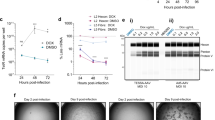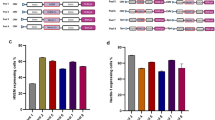Abstract
Helper-dependent (HD), high-capacity adenoviruses are one of the most efficient and safe gene therapy vectors, capable of mediating long-term expression1,2,3,4,5,6,7,8,9,10,11,12. Currently, the most widely used system for HD vector production avoids significant contamination with helper virus by using producer cells stably expressing a nuclear-targeted Cre recombinase and an engineered first-generation helper virus with parallel loxP sites flanking its packaging signal1,3,4,5,6,7,8,9,10,11,12. The system requires a final, density-based separation of HD and residual helper viruses by ultracentrifugation to reduce contaminating helper virus to low levels. This separation step hinders large-scale production of clinical-grade HD virus13. By using a very efficient recombinase, in vitro–evolved FLPe (ref. 14), to excise the helper virus packaging signal in the producer cells, we have developed a scalable HD vector production method. FLP has previously been shown to mediate maximum levels of excision close to 100% compared to 80% for Cre (ref. 15). Utilizing a common HD plasmid backbone1,7,8,10,11,12, the FLPe-based system reproducibly yielded HD virus with the same low levels of helper virus contamination before any density-based separation by ultracentrifugation. This should allow large-scale production of HD vectors using column chromatography–based virus purification13.
This is a preview of subscription content, access via your institution
Access options
Subscribe to this journal
Receive 12 print issues and online access
$209.00 per year
only $17.42 per issue
Buy this article
- Purchase on Springer Link
- Instant access to full article PDF
Prices may be subject to local taxes which are calculated during checkout



Similar content being viewed by others
References
Maione, D. et al. Prolonged expression and effective readministration of erythropoietin delivered with a fully deleted adenoviral vector. Hum. Gene Ther. 11, 859–868 (2000).
Mitani, K., Graham, F.L., Caskey, C.T. & Kochanek, S. Rescue, propagation, and partial purification of a helper virus–dependent adenovirus vector. Proc. Natl. Acad. Sci. USA 92, 3854–3858 (1995).
Kochanek, S. et al. A new adenoviral vector: replacement of all viral coding sequences with 28 kb of DNA independently expressing both full-length dystrophin and beta-galactosidase. Proc. Natl. Acad. Sci. USA 93, 5731–5736 (1996).
Parks, R.J. et al. A helper-dependent adenovirus vector system: removal of helper virus by Cre-mediated excision of the viral packaging signal. Proc. Natl. Acad. Sci. USA 93, 13565–13570 (1996).
Hardy, S., Kitamura, M., Harris-Stansil, T., Dai, Y. & Philips, M.L. Construction of adenovirus vectors through Cre-lox recombination. J. Virol. 71, 1842–1849 (1997).
Chen, H.H. et al. Persistence in muscle of an adenoviral vector that lacks all viral genes. Proc. Natl. Acad. Sci. USA 94, 1645–1650 (1997).
Schiedner, G. et al. Genomic DNA transfer with a high-capacity adenovirus vector results in improved in vivo gene expression and decreased toxicity. Nat. Genet. 18, 180–183 (1998).
Morsy, M.A. et al. An adenoviral vector deleted for all viral coding sequences results in enhanced safety and extended expression of a leptin transgene. Proc. Natl. Acad. Sci. USA 95, 7866–7871 (1998).
Morral, N. et al. Administration of helper-dependent adenoviral vectors and sequential delivery of different vector serotype for long-term liver-directed gene transfer in baboons. Proc. Natl. Acad. Sci. USA 96, 12816–12821 (1999).
Thomas, C.E., Schiedner, G., Kochanek, S., Castro, M.G. & Lowenstein, P.R. Peripheral infection with adenovirus causes unexpected long-term brain inflammation in animals injected intracranially with first-generation, but not with high-capacity, adenovirus vectors: toward realistic long-term neurological gene therapy for chronic diseases. Proc. Natl. Acad. Sci. USA 97, 7482–7487 (2000).
Sandig, V. et al. Optimization of the helper-dependent adenovirus system for production and potency in vivo. Proc. Natl. Acad. Sci. USA 97, 1002–1007 (2000).
Thomas, C.E. et al. Pre-existing anti-adenoviral immunity is not a barrier to efficient and stable transduction of the brain, mediated by novel high-capacity adenovirus vectors. Hum. Gene Ther., in press (2001).
Blanche, F. et al. An improved anion-exchange HPLC method for the detection and purification of adenoviral particles. Gene Ther. 7, 1055–1062 (2000).
Buchholz, F., Angrand, P.O. & Stewart, A.F. Improved properties of FLP recombinase evolved by cycling mutagenesis. Nat. Biotechnol. 16, 657–662 (1998).
Ringrose, L. et al. Comparative kinetic analysis of FLP and Cre recombinases: mathematical models for DNA binding and recombination. J. Mol. Biol. 284, 363–384 (1998).
Grable, M. & Hearing, P. cis and trans requirements for the selective packaging of adenovirus type 5 DNA. J. Virol. 66, 723–731 (1992).
Bett, A.J., Haddara, W., Prevec, L. & Graham, F.L. An efficient and flexible system for construction of adenovirus vectors with insertions or deletions in early regions 1 and 3. Proc. Natl. Acad. Sci. USA 91, 8802–8806 (1994).
Umaña, P., Jean-Mairet, J. & Bailey, J.E. Tetracycline-regulated over-expression of glycosyltransferases in Chinese hamster ovary cells. Biotechnol. Bioeng. 65, 542–549 (1999).
Southgate, T.D., Kingston, P.A. & Castro, M.G. Adenoviral vectors for gene transfer into neural cells in primary culture. In Current protocols in neuroscience. (eds Sibley, D.R. et al.) 4.23.1–4.23.40 (John Wiley and Sons, New York, NY; 2000).
Gerdes, C.A., Castro, M.G. & Lowenstein, P.R. Strong promoters are the key to highly efficient noninflammatory and noncytotoxic adenoviral-mediated trangene delivery into the brain in vivo. Mol. Ther. 2, 330–338 (2000).
Acknowledgements
This work was supported by grants from the Medical Research Council (MRC, UK), Biotechnology and Biological Sciences Research Council (BBSRC, UK), The Parkinson's Disease Society, The Royal Society, and European Union-Biomed program grants Contract No. BMH4-CT98-3277 and BMH4-CT98-0297. P.R.L. was a research fellow of The Lister Institute of Preventive Medicine, and D.S. was funded through a BBSRC studentship. We kindly thank A. Francis Stewart for providing us with the pCAGGSFLPe-IRESpuro plasmid, and Stefan Kochanek and Gudrun Schiedner for providing us with the pGS46 plasmid.
Author information
Authors and Affiliations
Corresponding author
Rights and permissions
About this article
Cite this article
Umaña, P., Gerdes, C., Stone, D. et al. Efficient FLPe recombinase enables scalable production of helper-dependent adenoviral vectors with negligible helper-virus contamination. Nat Biotechnol 19, 582–585 (2001). https://doi.org/10.1038/89349
Received:
Accepted:
Issue Date:
DOI: https://doi.org/10.1038/89349
This article is cited by
-
Embryonic type Na+ channel β-subunit, SCN3B masks the disease phenotype of Brugada syndrome
Scientific Reports (2016)
-
An inhibitor of fibroblast growth factor receptor-1 (FGFR1) promotes late-stage terminal differentiation from NGN3+ pancreatic endocrine progenitors
Scientific Reports (2016)
-
Impact of adenovirus life cycle progression on the generation of canine helper-dependent vectors
Gene Therapy (2015)
-
Sustained production of a soluble IGF-I receptor by gutless adenovirus-transduced host cells protects from tumor growth in the liver
Cancer Gene Therapy (2013)
-
Virus-mediated Genetic Surgery: Homologous Recombination With a Little “Helper” From My Friends
Molecular Therapy - Nucleic Acids (2012)



